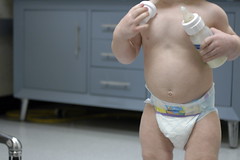assessments. assessments. and more assessments. because of the micropreemie odds of developing “invisible disabilities” there are a seemingly endless number of developmental evaluations scheduled for as long as people might think there’s a risk for missing a problem that might best be addressed earlier rather than later.
it seems like a only yesterday that odin had his prior assessment which is performed by a case worker from a county “early intervention” program that provides services services for children who are developmentally delayed, or at risk of developing delays. but the county is not the only party interested in odin’s well-being ( presumably to help reduce the costs of expensive “special needs” services when he gets older ) – the neonatal intensive care unit also likes to keep track of odin’s progress so they have their separate assessment program which has the added benefit ( for them ) of tracking outcomes.
not surprisingly the nicu assessments are a little more nerve-wracking because they’re performed in a colder ( atmospherically speaking ) clinical environment, which odin associates with painful shots and immediatly puts him in a mood that might be characterized as uncooperative since his experience tells him that at any moment two people are going to come in and hold him down and poke him in the leg.
regardless, we walked into the assessment fairly positive that we’d see results similar to those found during his early intervention assessment – namely that when you adjust his age to 14 months that he’s probably about on track in gross and fine motor skills, problem solving and socialization, but probably just a bit “behind” in language.
but after answering all their questions and watching him and poking and prodding the specialist concluded that not only is he not behind in any areas when compared to his age-adjusted peers – she thought he was all “caught up” to kids his actual age!
yes, that’s right, when looking across all the measured skills – including language – in her professional opinion odin is officially and finally a boy like any other, which is quite a big milestone for him ( and us ) because the professionals will almost always “adjust” the age of a 25 weeker for at least the first two years.
so i guess in a funny way it makes sense that while i was trying to capture a shot of him before his assessment in the exam room, i just about gave up on the mission impossible. he’s so big and fast that it’s proving increasingly difficult to capture him in enclosed quarters without cutting off his head and feet. he really is just like any other rambunctious, roving toddler and we couldn’t ask for any better christmas gift.
oh, and if anyone is wondering, we were chastized for letting him walk around with a bottle ( hopefully it won’t go down on permanently on the “parents” section of the assessment ). yes, we know it’s bad for the teeth and we don’t usually let him, but he slept in and didn’t have time for breakfast so cut him some slack. that said, i also didn’t know the current recommendation is that a child should be 100% bottle-free by a year. so we’re going to have to work on that ( he self-weened from “the font” months ago ).
i must admit that i faced a bit of a conundrum with this post because while many people enjoy following along with odin’s stupendous progess, lots of other people find that i have a knack for providing educational information that they might not otherwise had known. i added the following bit of additional information that i had originally deleted because i thought it might seem overly cynical ( or maybe just overly skeptical ). but in retrospect i think some people might find it informative. i can’t stress strongly enough that we have no evidence that anyone performing odin’s assessments is biasing the outcome in any way and they all seem very professional.
while we’re fantastically happy with the great assessment, i almost feel remiss to not add that there is some debate about the differing incentives of each of the groups performing the assessments. some people believe that the county early intervention programs have a vested interest providing "negative" conclusions because it helps them when it comes time to apply for funding from the state – i.e. they get more money if they have children in need of their services ( and somewhat relatedly, i was surprised to learn that some states are having a difficult time sustaining funding for their EI programs in part because their is evidence from long term research that early intervention basically has no effect on cognitive and academic skills of very low birth weight ( < 2000 grams ) infants. )
but still others claim that the nicu has an interest in providing overly "positive" assessments because it helps them bolster their outcomes claims – i.e. they get more beds filled if they can "prove" that their outcomes are as good or better than other competing nicus.
is the difference between the assessments evidence of the differing incentives? who knows, but it’s holiday season so we’ll choose to accentuate the positive

